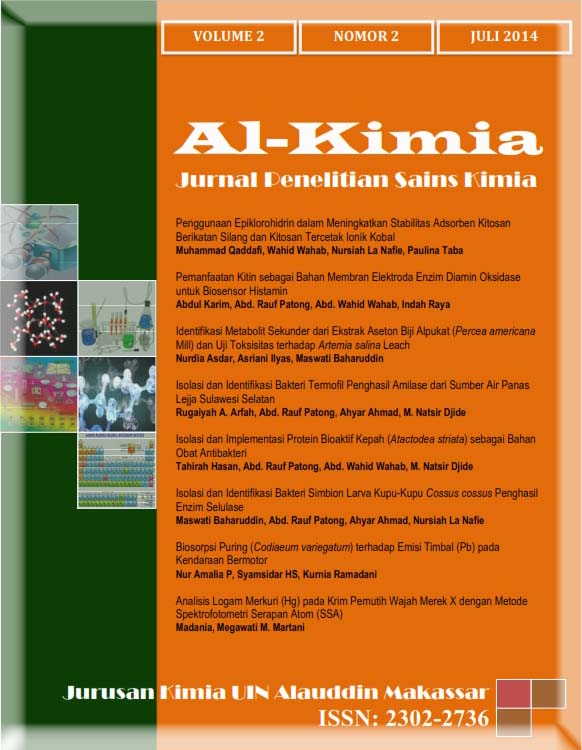Pemanfaatan Kitin Sebagai Bahan Membran Elektroda Enzim Diamin Oksidase Untuk Biosensor Histamin
Abstract
This research aims to utilize isolated chitin from shrimp waste to develop histamine biosensors basedon diamine oxidase (DAO) enzyme electrode with cyclic voltammetry. DAO enzyme trapped in the chitin-cellulose acetate membranes with various comparisons were layered on the Pt electrode. Histamine will be oxidized by the DAO enzyme produces aldehydes and H2O2 which acts as an electron transfer mediator. Biosensor performance is influenced by several factors, especially the concentration and composition of electrode membranei.Comparison of chitin-cellulose acetate used in this study were 1:1, 2:1 and 3:1. Isolated chitin from the shrimp waste is chemically obtainedrendamen of 23.6%, and characterization of electrode membrane by FTIR and cyclic voltammetry showed that the DAO enzymes electrode with chitin-cellulose acetate membrane 2:1 is the best composition.
Downloads
References
Aziz, A. A., 2007, Developmen of A Biosensor Based On Amine Oxidase From Cicer arietinum For The Detection Of Biogenic Amines, Faculty of Chemical and Natural Resources Engineering, University Teknologi Malaysia.
BSN, 2009, Cara Uji Kimia – Bagian 10: Penentuan Kadar Histamin dengan Spektrofluorometri dan Kromatografi Cair Kinerja Tinggi (KCKT) pada Produk Perikanan, SNI 2354.10:2009.
Fang, Y., 2011, Label-Free Biosensor for Cell Biology, Int.Journal of Electrochemistry, Review Article Volume 2011 Article ID 460850.
Keow, C.M., Bakar, F.A., Salleh, A.B., Heng, L.Y., and Wagiran R., 2012, Screen-Printed Histamine Biosensor Fabricated from the Entrapment of Diamine Oxidase in a Photocured Poly(HEMA) Film, Int. J. Electrochem. Sci., 7: 4702-4715.
Lange, J. and Wittmann, C., 2001, Enzyme Sensor Array for the Determination of Biogenic Amines in Food Samples. Analytical and Bioanalytical Chemistry.
Niculescu, M., Nistor, C., Ruzgas, T., Frebort, I., Sebela, M., Pec, P. and Csoregi, E., 2001, Detection of Histamin and Other Biogenic Amines Using Biosensors Based on Amine Oxidase. Inflamm.res. 50: 146-148.
Othman, N., Bakar, F.A., Salleh, A.B., Heng, L.Y., and Wagiran R., 2006, A Preliminary Investigation on Histamine Biosensor Constructed from Diamine Oxidase Immobilised onto an Oxygen Probe, Malaysia Journal of Analytical Science, 10: 137-142.
Telsnig, D., Terzic, A., Krenn, T., Kassarnig, V., Kalcher, K., and Ortner A., 2012, Development of a Voltammetric Amine Oxidase-Modified Biosensor for the Determination of Biogenic Amines in Food, Int. J. Electrochem. Sci., 7: 6893-6903.
Wimmerova. M. and Macholan, L., 1999, Sensitif Amperometric Biosensor for the Determination of Biogenic and Synthetic Amines Using Pea Seedlings Amine Oxidase: A Novel Approach for Enzyme Immobilization. Biosensor and Bioelectronics. 14: 695-702.
Authors who publish with this journal agree to the following terms:
1) Authors retain copyright and grant the journal right of first publication with the work simultaneously licensed under a Creative Commons Attribution License that allows others to share the work with an acknowledgement of the work's authorship and initial publication in this journal.
2) Authors are able to enter into separate, additional contractual arrangements for the non-exclusive distribution of the journal's published version of the work (e.g., post it to an institutional repository or publish it in a book), with an acknowledgement of its initial publication in this journal.
3)Authors are permitted and encouraged to post their work online (e.g., in institutional repositories or on their website) prior to and during the submission process, as it can lead to productive exchanges, as well as earlier and greater citation of published work (See The Effect of Open Access).


